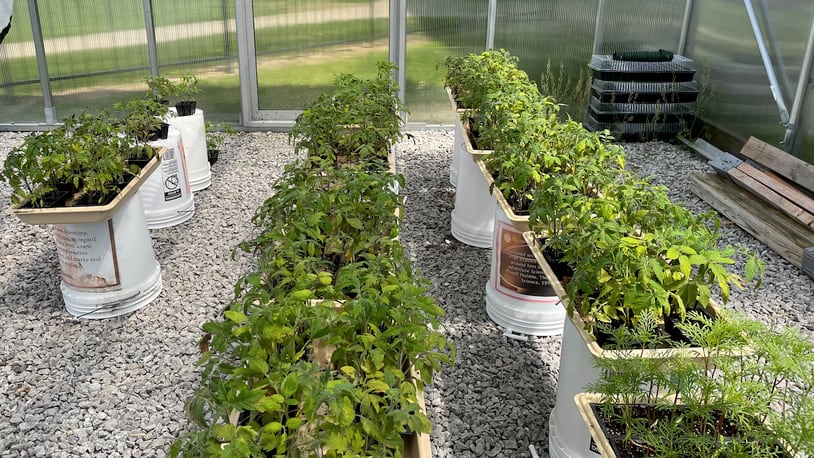The central piece of the work, however, is a multi-use garden area in the school’s courtyard, where several natural places are blended into an outdoor classroom for use by the entire school, not just science.
“When we did the adoption, it was an opportunity to dream big about what we wanted for our students. The basic structure was fencing the courtyard, creating a raised bed and a greenhouse. There is a storage area for tools,” Kettlewell said. The garden areas have been evolving since the school opened but it was a massive school-wide effort at the very beginning that laid the groundwork. “I was always interested in the landscape of the school and (local resident) Jim Pelley was concerned about the landscape. The plan was to have all the students take part in planting trees, many different kinds of trees. Most of the variety of trees is a product of that time. There was 100 percent total school involvement in the project. Getting kids involved was so important to me.”
That involvement included not only planting the trees, but taking part in classroom projects built around the effort, such as writing poems about it.
Student effort has always been a major part of the school’s land lab. That led to the formation of the school’s Earth Club established. Members developed a project where they planted tomato seeds and sold the produce to teachers and staff, raising more than $200 for the various garden efforts.
“Last year, the Earth Club was small, but dedicated. This year, we hope it will be bigger and involve more students,” she said.
Since part of the plan for the courtyard garden is to have a natural space everyone can use and teachers in other subject areas take advantage of the opportunity, they are adding benches and picnic tables to the garden. These are not just any tables and benches. These are the kind created from plastic bottle caps. Students collected and sorted the caps which were used for six benches Kettlewell brought back from Indiana in her horse trailer.
The next step was to do the same to collect enough caps for picnic tables and five of them will need to be picked up soon.
“It was another piece of student effort,” she said, adding, “There was a lot of community support.”
It was not all plastic bottle caps, however. Grants from the Greater Oxford Community Foundation and Butler Rural Electric Cooperative’s Community Connection were used for the purchase of the greenhouse and planting tables inside.
Kettlewell described the land lab as the fenced-in garden but more than that with sections all over the grounds.
The garden also includes a home for purple martins in special houses with help from the Miami University Dragonfly Project. The house can be raised and lowered so students can see the young birds without disturbing them.
The project has been designated a Wild School Site by the National Wildlife Federation and is also a Monarch Way Station with 30 milkweed plants providing a place for the butterflies on their long migration.
Students have been recording the weather for three years so if anyone in the school needs to research the weather from a particular date, they have that information.
Kettlewell said they are also looking at establishing a prairie area on the grounds which would attract more wildlife and provide another study area.
“We have been seeing more wildlife, birds and insects and a lot of plants,” she said. “I’ve seen wild turkeys at the edge of the field and once during a fire drill, when everyone was outside, an eagle flew over.”
She said when the school opened in 1989, they visited other schools with land labs and came back with big ideas which grew over time.
“The dream was pretty big when we started. The ideas were big – greenhouse, raised beds, a rain garden on the site. The idea of a prairie was big,” she said. “We tried to prepare an area where teachers can go out and enjoy it.”
About the Author
